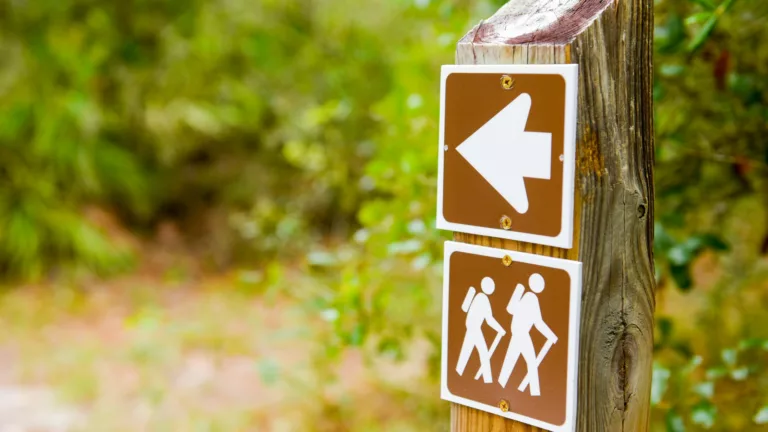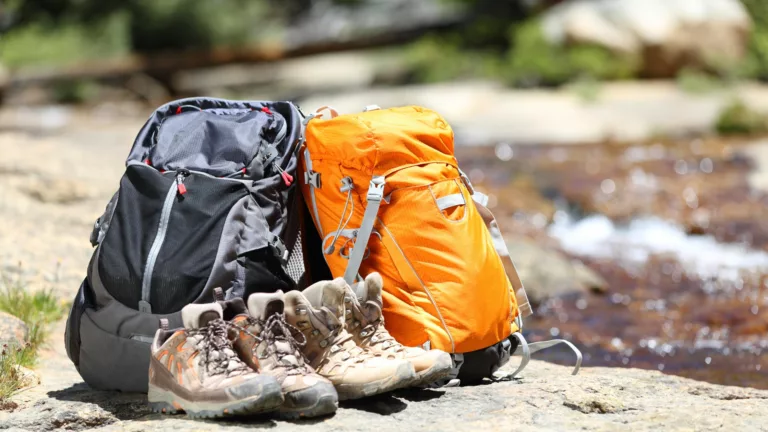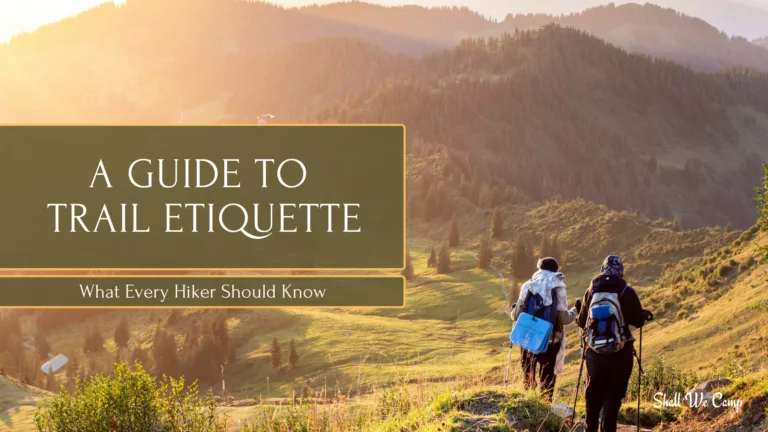There’s nothing quite like the peace and beauty of a good hiking trail, until someone ruins it with loud music, litter, or a lack of common courtesy. Understanding basic trail etiquette makes the experience better for everyone.
Respecting the trail and those you share it with is part of being a responsible outdoor enthusiast.
Trail etiquette plays a major role in preserving the beauty and safety of our outdoor spaces. It can sometimes be challenging when hikers have different expectations or personal habits on the trail. In this article we'll focus on how to find your way through conflicts and maintain a calm atmosphere while enjoying nature.
Affiliate Disclaimer: This site contains affiliate links, which means I may earn a commission on purchases made through these links at no extra cost to you.
Table of Contents
Understanding Trail Etiquette

Respecting trail etiquette means understanding that every visitor plays a part in keeping nature accessible and enjoyable. Conflicts can occur when different users clash over space or behavior, and even a small misunderstanding can disrupt an otherwise pleasant outdoor experience. It doesn't matter if you are an exeperienced hiker or just someone who takes occasional walks, sticking to clear guidelines makes a very important impact. When all hikers are mindful of their surroundings, the overall atmosphere improves for everyone.
In addition to reducing conflicts, proper trail behavior helps protect sensitive ecosystems. A respectful hiker minimizes soil erosion, preserves native vegetation, and limits waste left behind. With more people stumbling upon outdoor adventures each year, the need for mutual respect and mindful practices becomes essential especially if we expect nature to remain pristine for future visitors.
Essential Practices for Trail Etiquette
Observing basic trail etiquette can smooth the way for all hikers and significantly reduce misunderstandings on the path. The following practices are as important as knowing the route itself:
- Yield the Path: Allow faster walkers, cyclists, or others coming from behind to pass safely. Particularly when moving uphill, it is courteous to step aside and let others pass without delay.
- Keep Noise to a Minimum: Most hikers come to enjoy the serene sounds of nature. Lowering your voice, avoiding loud conversations, or reducing music volume helps maintain a peaceful environment and minimizes disturbances to wildlife.
- Stay on Marked Trails: Venturing off designated paths can harm fragile ecosystems. Following marked routes safeguards native flora and fauna and allows the beauty of the area to remain intact.
- Leave No Trace: Whether this means carrying out your trash or taking care not to disturb the natural setting, each small action contributes to a larger positive impact on the environment.
- Be Prepared: Familiarize yourself with local trail rules and carry essential supplies such as maps, water, and a first-aid kit. Being well-prepared makes your adventure more enjoyable and contributes to the overall safety of everyone on the trail.
By following these straightforward guidelines, you help foster a respectful and safe trail environment. A little consideration goes a long way in making sure that everyone can enjoy nature without unnecessary conflicts.
Mastering the Basics on the Trail
If you are new to hiking, the very first step is to remember that the trail is a shared space. Before you kick things off on your adventure, take time to learn about local customs and rules. Reading park brochures, visitor guides, or exploring online resources can provide useful information about what to expect and what is expected of you.
It is also a good idea to plan your trip during hours when trails are less populated. This approach allows you to gradually get used to the pace of the outdoors and build confidence in your skills. As you become more comfortable, even a brief conversation with a fellow hiker can reveal practical insights into local etiquette and any specific concerns regarding that area.
A Quick Guide to Handling Conflicts on the Trail

Even with the best intentions, disagreements on the trail can occasionally occur. Approaching these situations calmly can prevent escalation and maintain the enjoyable atmosphere. Here are some clear steps to follow when conflicts arise:
- Stay Calm: Take a deep breath and avoid an impulsive reaction. A moment of cool-headed reflection often helps ease rising tension.
- Communicate Clearly: A friendly word or simple explanation can work wonders for clarifying misunderstandings. Expressing your viewpoint calmly can help resolve many issues without further stress.
- Yield When Needed: If a disagreement intensifies, stepping aside or giving way may be the best solution. Keeping safety and a stress-free environment in mind is really important.
- Assess the Situation: Sometimes, minor conflicts are not worth further engagement. It might be better to let small incidents slide so you can focus on enjoying your adventure.
- Know When to Seek Help: In situations where safety is at risk or the conflict escalates, do not hesitate to contact park authorities or ask a fellow experienced hiker for assistance.
Challenges and Considerations on the Trail
Even when you follow all the basic etiquette rules, several challenges might test your patience on the trail. Being aware of these challenges beforehand can make it easier to handle them if they appear.
- Crowded Trails: Popular paths can get quite busy, especially on weekends or holidays. When space is limited, it helps to plan ahead, be patient, and adjust your pace accordingly. A little extra patience in crowded conditions can prevent unnecessary friction among hikers.
- Noise and Distractions: In areas with many visitors, background noise from vehicles, bicycles, or group activities might be noticeable. Recognizing that some ambient sound is part of the outdoor experience can help you remain relaxed instead of fixated on disturbances.
- Respecting Personal Space: Personal space preferences vary from one hiker to another. Some may enjoy a friendly chat while others prefer quiet solitude. Being observant and allowing for personal space can prevent misunderstandings and ensure everyone feels comfortable.
- Local Regulations: Different trails and parks may have unique rules regarding group size, pet behavior, or restricted areas. Paying attention to posted signs and guidelines helps maintain safety and preserves the natural setting for all visitors.
Understanding and preparing for these challenges is key to having a smooth outdoor experience. Often, a few moments of mindfulness can turn a potentially stressful situation into an opportunity to learn and adapt.
Crowded Trails
Encountering crowded trails for the first time can feel overwhelming. Slowing down to let groups pass and choosing less busy paths when possible can help reduce tension. Remember, a bit of extra patience on crowded days makes all the difference.
Noise and Distractions
The natural world is filled with sounds, even if some moments are interrupted by background noise. When faced with such distractions, try to focus on the overall ambiance of nature. Bringing a book or simply enjoying the sounds of rustling leaves can help you feel at ease despite occasional disruption.
Respecting Personal Space
Personal space is very important on the trail. Watch for subtle cues that indicate if someone prefers minimal interaction, and adjust your proximity accordingly. A brief smile or nod can often replace a lengthy conversation, ensuring mutual comfort without intruding on someone’s personal ride.
Following Local Regulations
Local rules and signage are put in place to protect both the environment and its visitors. Make it a habit to check these rules, as they can vary based on season or specific trail conditions. Adhering to these regulations not only helps you avoid conflicts but also supports the long-term health of natural spaces.
Check out my article on the 10 Must-Have Camping Cookware for Outdoor Cooking. It's packed with essential gear recommendations to make your camping meals even more delicious and hassle-free!
Equipment and Preparation for a Successful Hike

Proper trail etiquette is not solely about how you behave on the path; it also involves being well-prepared. Having the right gear and supplies makes it easier to cope with unexpected challenges.
Investing in quality hiking equipment is extremely important. Sturdy footwear, layered clothing, and a reliable backpack can all contribute to a comfortable hike. Equally important is carrying basic necessities such as maps, water, snacks, and a first-aid kit. These precautions not only help you handle emergencies but also show that you respect both your journey and the environment.
- Proper Footwear: Shoes or boots designed for hiking provide essential support on uneven terrain and help lower the risk of injury.
- Navigation Tools: A map or GPS device assists in staying on course and understanding the trail layout, ensuring you do not accidentally stray from safe paths.
- First-Aid Kit: Being prepared with a basic first-aid kit allows you to address minor injuries or health issues until assistance is available.
- Hydration and Nutrition: Carry enough water and healthy snacks to maintain energy during long hikes, ensuring you remain alert and in good spirits throughout your adventure.
- Appropriate Clothing: Dressing in layers and paying attention to weather changes keeps you comfortable and safe, no matter how the conditions fluctuate on the trail.
Thoughtful preparation demonstrates respect for yourself and fellow trail users. It reinforces the importance of etiquette and contributes to a safe, enjoyable outdoor experience for everyone.






